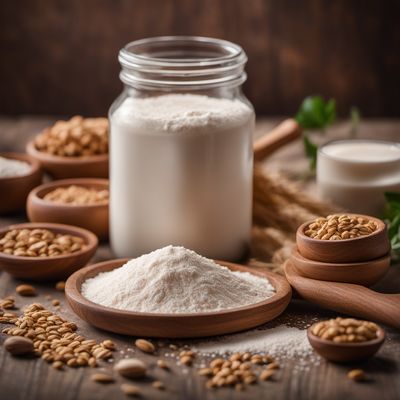
Ingredient
Spelt flour, wholemeal
Rediscovering the Ancient Grain: Wholemeal Spelt Flour
Wholemeal spelt flour is made from grinding the whole grain of spelt, an ancient wheat variety. It has a slightly nutty and sweet flavor, with a finer texture compared to regular whole wheat flour. This flour is rich in fiber, protein, and essential nutrients, making it a wholesome choice for baking bread, pastries, and other baked goods.
Origins and history
Spelt is one of the oldest cultivated grains, dating back thousands of years. It was widely grown in ancient civilizations, including the Egyptians and Romans. Over time, spelt fell out of favor and was replaced by modern wheat varieties. However, in recent years, there has been a resurgence of interest in spelt due to its nutritional value and unique flavor. Today, spelt is cultivated in various parts of the world, including Europe, North America, and Australia.
Nutritional information
Wholemeal spelt flour is a good source of fiber, protein, and essential minerals like manganese and phosphorus. It is also rich in B vitamins and antioxidants. This flour has a lower gluten content compared to regular wheat flour, making it easier to digest for some individuals with gluten sensitivities. However, it is not suitable for those with celiac disease or severe gluten allergies.
Allergens
Gluten (not suitable for celiac disease or severe gluten allergies)
How to select
When selecting wholemeal spelt flour, look for organic or locally sourced options for the best quality and flavor. Check the packaging for any signs of damage or moisture. Wholemeal spelt flour should have a light brown color and a fine texture. Store it in an airtight container in a cool, dry place to maintain its freshness and prevent spoilage.
Storage recommendations
To store wholemeal spelt flour, transfer it to an airtight container or sealable bag and store it in a cool, dry place. It can be stored for up to 6 months. Wholemeal spelt flour has a higher oil content compared to regular wheat flour, so it is more prone to spoilage. To extend its shelf life, consider storing it in the refrigerator or freezer.
How to produce
Wholemeal spelt flour can be produced by grinding whole spelt grains in a grain mill or using a high-powered blender. It can also be purchased from specialty stores or online retailers. Growing spelt requires specific conditions, including cool temperatures and well-drained soil. It is best suited for commercial cultivation rather than home production.
Preparation tips
Wholemeal spelt flour can be used as a substitute for regular wheat flour in a variety of recipes, including bread, muffins, pancakes, and cookies. It adds a nutty flavor and a tender texture to baked goods. When using wholemeal spelt flour, it is important to note that it absorbs more liquid than regular flour, so adjustments may be needed in the recipe. Experiment with different ratios and combinations to achieve the desired results.
Substitutions
Wholemeal spelt flour can be substituted with regular whole wheat flour or other alternative flours like einkorn or kamut flour. However, keep in mind that the flavor and texture may vary. Adjustments may be needed in the recipe to accommodate the different properties of the substitute flour.
Culinary uses
Wholemeal spelt flour is commonly used in baking bread, pastries, cakes, and cookies. It can also be used to make pasta, pancakes, and waffles. This versatile flour adds a unique flavor and nutritional value to various dishes. Experiment with different recipes and enjoy the wholesome goodness of wholemeal spelt flour.
Availability
Europe, North America, Australia

